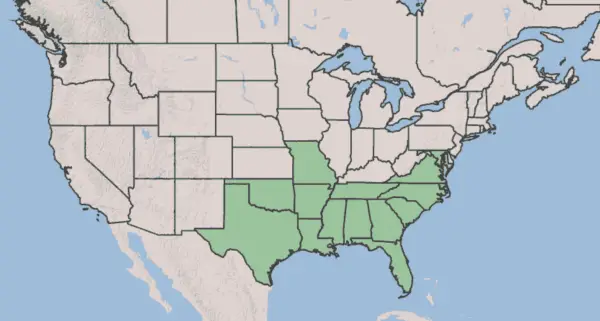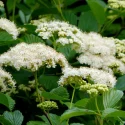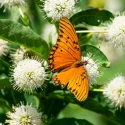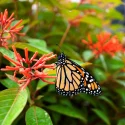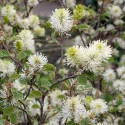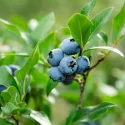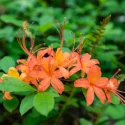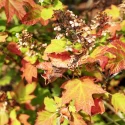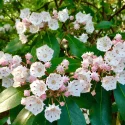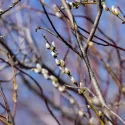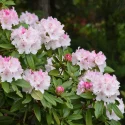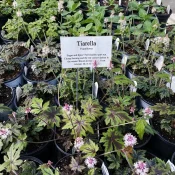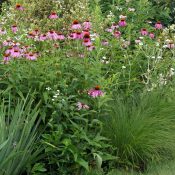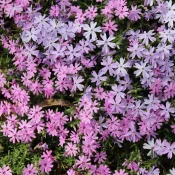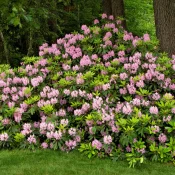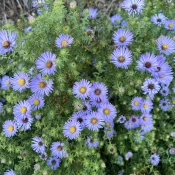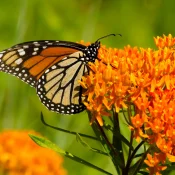American Beautyberry
American Beautyberry is a gorgeous shrub native to the southeastern United States known for its electric purple berries that appear in the late summer/early fall. The berries look like candy for birds and can last on the branches through the winter. They are fast growers, like sun to part sun, and can get 4-6 feet tall. This was once one of the most common shrubs in the south—let’s bring it back! Discover planting tips and varieties below.
- Full Sun, Part Sun
- Medium Shrub (6-10')
- Summer flowers
- Bird favorite
Electric purple berries!
This native plant is such a stunner, especially when you see one with berries in the fall or winter. In this article, we’ll explore its native range, offer planting tips, and share some sourcing recs.
Homeowners thinking about adding this shrub to their landscapes might want to start with a simple question:
What are the benefits of planting American Beautyberry?
Planting native plants makes our yards and spaces gorgeous while helping the birds, butterflies, and animals (and helping save us time.) Here are three reasons why planting native is worth it:
- Wildlife support. Without native plants, iconic animals like Monarch butterflies and songbirds won’t have the food or homes needed to survive.
- Native plants save time and money: after the first year of getting established, native plants are happy with normal rainfall.
- Multi-season, cinematic beauty. Bored seeing your yard stay the same, thanks to static evergreen shrubs? American Beautyberries offers dramatic, gorgeous seasonal change along with resilience.
The American Beautyberry is due for a comeback
According to the 1925 edition of North American Wildflowers, the American Beautyberry (Callicarpa americana) “is one of the most common plants of the Southern States.”
Imagine how incredible it must have been 100 years ago to see thousands of these shrubs in the southern landscape covered in electric purple berries.
The 1925 North American Wildflowers continues, “This native species is much more showy than the related Asiatic species, but is rarely cultivated. It occurs from Florida northward to Virginia and westward to Texas and Missouri.” Climate change has recently extended places where this shrub can thrive (you’ll find it thriving in arboretums in Pennsylvania.)
Wondering what the American Beautyberry’s native range is? Here you go:
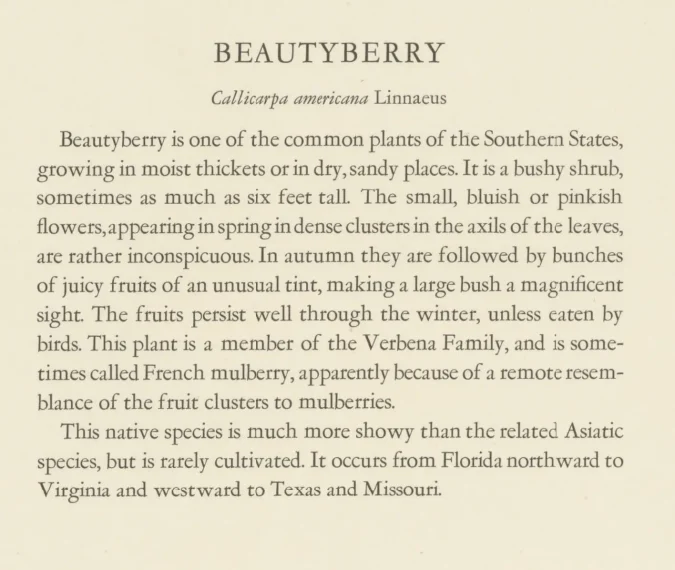
What is American Beautyberry’s native range?
American Beautyberries are native to the Southern United States, from Virginia south to Florida, and west to Texas.
American Beautyberry throughout the seasons
No matter the season, American Beautyberries look gorgeous.
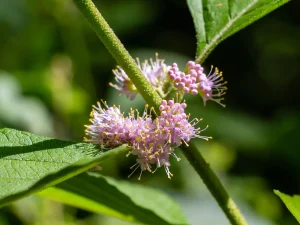
Spring
In the spring, American Beautyberries send out bright green leaves and cover their stalks with tiny fairy-like purple flowers.
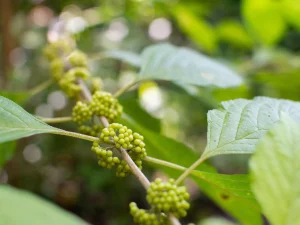
Early Summer
In the early summer, American Beautyberry flowers give way to green berries, which then change to purple in a gorgeous gradient.
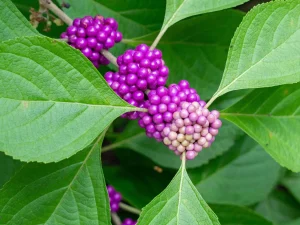
Late Summer into Fall
In the summer and early fall, the berries turn on their neon purple show alongside green leaves.
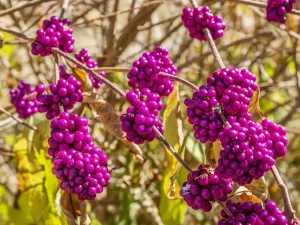
Winter
In the fall in northern climates, the leaves change to a warm yellow before they fall. In more southern locations like Florida, the leaves remain evergreen. The electric purple berries remain on Beautyberry's stem, making it easy for songbirds to find a snack. And then back to the beautiful fairy-like flowers all over again in the spring.
NC State Extension shared a great overview video of the plant throughout the seasons, including its fairy-like spring blossoms.
Stay away from non-native beautyberries
Many plants have native and non-native species; azaleas, lilies, rhododendrons, and wisteria are examples of plants with family trees spread across North America, Europe, or Asia.
Four species of beautyberry are often sold in nurseries, and only one species is native to North America.
- American Beautyberry (Callicarpa americana) is the North American native species
- Japanese Beautyberry (Callicarpa japonica) no surprise, is native to Japan
- Chinese Beautyberry (Callicarpa dichotoma) — many cultivars in nurseries come from this plant
- Bodinier’s Beautyberry (Callicarpa bodinieri) is also native to China
How can I make sure I’m planting a native American Beautyberry?
Look at the tag—Latin names were invented precisely for this purpose.
Every plant has only one Latin name. The only plant you’ll want to buy will have the Callicarpa americana name on the tag.
If it doesn’t include this Latin name, be wary.
How else can I tell if the beautyberry is native?
There is one other way to check the native vs. non-native: look at the berry stems. (Sincere thanks to Cassandra from Kentucky for sharing this tip!)
How do I know if the beautyberry is native or not?
At the nursery looking at beautyberries? Look at the berries. If the berries are jutting out on a stem—it’s non-native.
Non-native Beautyberry
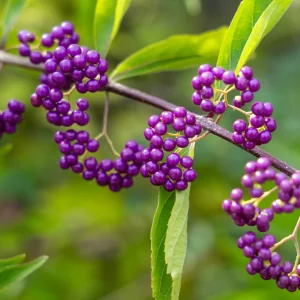
Do the berries hang off stems? That is the telltale sign of one of the Asian species.
Native Beautyberry
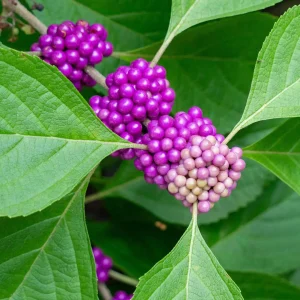
Do the berries hug the stem in beautiful round orbs? That’s a North American Callicarpa americana.
Finally, to be sure you’re planting native, visit a native nursery. Here’s our list of 100+ native nurseries across America.
Where does American Beautyberry do best?
American Beautyberries are so easy to grow because they do well is lots of different areas:
- Full sun to part-sun
- Minimal care after the first year of getting established
- Plant them underneath trees on the edges of your property or in the center of gardens with shorter plants in front
Plant a few, together!
American beautyberries look especially awe-inspiring when planted in multiples. If there is a sunny or part-sun area along your driveway or at the edge of your yard, plant a few.
Bird-watching bonus: If you plant them near a window view, you can watch the birds eat the berries throughout the fall and winter.
No pesticides or herbicides
Avoid using pesticides or herbicides near American Beautyberry plants, as they can harm the birds and pollinators that visit the plant.
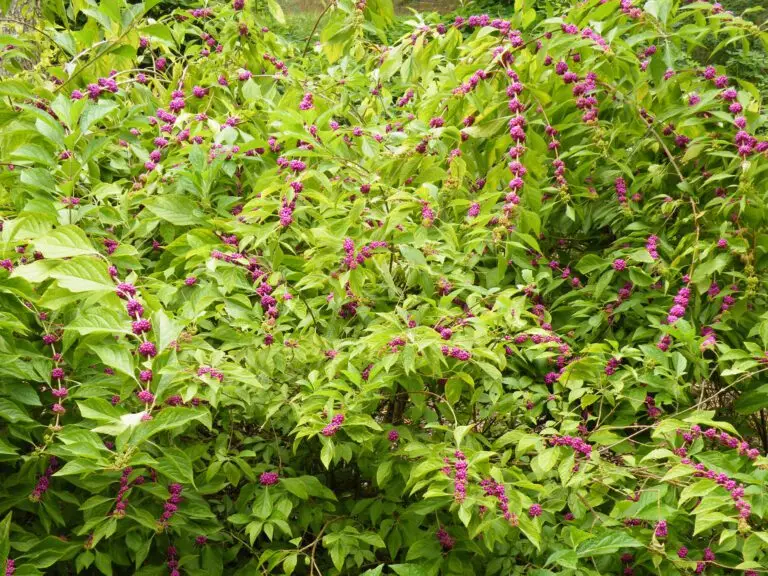
FAQs
Can I grow American Beautyberry by seed?
If you’re patient, you can grow American Beautyberry by seed. It will take a few years for the plant to reach bushy-size. To plant by seed:
- Take some of the bright purple berries in the fall
- Plant them directly in the garden, 1/2″ deep
- Wait 3-5 months
- Shoots will emerge in the spring
Can I grow American Beautyberry by cuttings?
Yes! You can grow American Beautyberry by cuttings in the spring. To grow from a cutting:
- Wait until the spring
- Cut 4-6 inch stems from a healthy plant
- Dip the bottom tip of the cutting into rooting hormone before planting (if needed, you can remove the leaves on the bottom to help place them in the dirt)
- Place the cuttings in small pots with an all-purpose soil mix (nothing fancy is needed)
- Keep your cutting in a warm place indoors in bright, indirect light
- The cutting should begin to grow 2-3 weeks after planting
- It will be ready to plant in your garden 2 months later!
How much space do American Beautyberries need?
American Beautyberry shrubs get 4-6′ wide. If you are planting them while they are smaller, put perennials alongside to help fill in the space. As the Beautyberry grows, dig up the perennials and move them to other spots in your garden to give them room to grow.
Where can I find American Beautyberry plants?
As you look for American Beautyberry, we have a tip:
Local blooms, fewer glooms
Find native plants near you
Local plants and seeds—grown within 800 miles—are best suited for your garden. This also fosters cross-pollination among locally grown plants, enhancing their resilience for generations to come. Stay local for a happy garden!
For example, an American Beautyberry from southern Florida won’t have the same genetic makeup as one from Virginia—and that difference matters.
That’s why The Plant Native lists the state or province of every nursery and online store we recommend. To take full advantage of the resilience and cross-pollination benefits of local plants, look for native nurseries closest to your area.
Buy American Beautyberry plants online
- American Meadows (Vermont)
- Arbor Day Foundation (Lincoln, Nebraska)
- Monticello (Charlottesville, Virginia)
- Native Gardeners (Euless, Texas)
Buy or find American Beautyberry plants nearby
There are four reliable ways to find American Beautyberry plants for your yard in your community:
Where can I find seeds and plants?
Finding native plants can be challenging (we partly blame Marie Antoinette.) To make it easier, we’ve assembled four sourcing ideas.
Native Nursery List
300+ native nurseries makes finding one a breeze
Online Native Plant Sellers
We've included 100+ online resources to help
Society Plant Sales
Every state has a native plant society; find yours
Online Communities
Local Facebook groups are a great plant source
What pairs well with American Beautyberry?
American Beautyberries look fantastic alongside native shrubs such as azaleas, mountain laurel, rhododendrons, and sweetshrubs. If you have a fence or trellis nearby, plant the native vines Coral Honeysuckle or American Wisteria. If you live in the South, check out native Passionflower vines. If you want to plant a multi-month butterfly buffet (and who doesn’t?), plant milkweed, coneflower, mountain mint, and asters. Or visit our Guide to Native Host Plants for Butterflies.
We hope you’re inspired to add a splash of electric purple to your landscape with American Beautyberry! Not only is this native shrub stunning to look at, but it’s also a great way to support local ecosystems. By following our cultivation and care tips, you can easily incorporate this hardy and beautiful plant into your garden or natural area. Keep the birds happy with our Guide to the Best Native Plants for Birds. Or, keep making your yard gorgeous with our Best Native Trees for Front Yards. Happy planting!
Sources
- Gil Nelson. Best Native Plants for Southern Gardens: A Handbook for Gardeners, Homeowners, and Professionals. (2010).
- NC State Extension, American Beautyberry
- NC State Extension, Japanese Beautyberry
- Brakie, M. 2010. Plant fact sheet for American beautyberry (Callicarpa americana). USDA-Natural Resources Conservation Service, East Texas Plant Materials Center. Nacogdoches, TX, 75964. (PDF).
- Chadwick, Pat. Piedmont Master Gardeners, Callicarpa (Beautyberry). October 2015.
- USDA Plants Database, Callicarpa Americana. n.d.
